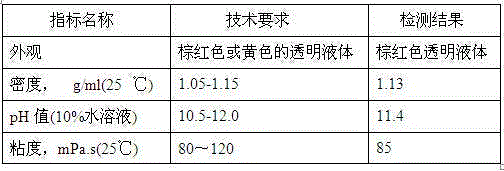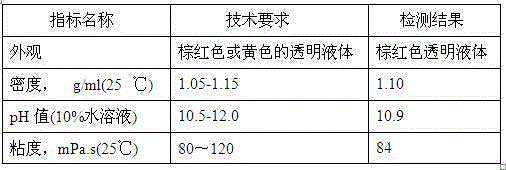Production method of polymeric chelating agent capable of being used for removing various heavy metal ions in wastewater
A technology of polymer chelating agent and heavy metal ions, applied in chemical instruments and methods, water pollutants, water/sewage treatment, etc., can solve the problems of unreasonable raw material ratio, long reaction time, high reaction temperature, etc., and achieve good flocculation Precipitation effect, obvious effect, effect of lowering reaction temperature
- Summary
- Abstract
- Description
- Claims
- Application Information
AI Technical Summary
Problems solved by technology
Method used
Image
Examples
Embodiment 1
[0056] Embodiment 1 A kind of production method that can be used for removing the polymer chelating agent of multiple heavy metal ions in waste water
[0057] The synthesis reaction of the polymer chelating agent is carried out in a 1500L enamel kettle.
[0058] The polymer chelating agent is polyethylenimine dithiocarbamate.
[0059] (1) Carbon disulfide high tank feeding
[0060] Use compressed air to press 98.5kg (1296mol) carbon disulfide from the storage tank to the carbon disulfide high level tank, and keep the height of the upper water layer of the carbon disulfide high level tank at 10-15mm.
[0061] (2) Synthetic kettle feeding
[0062] 630kg (35000mol) of deionized water, 190kg of industrial NaOH with a mass concentration of 30% (the molar number of NaOH is 1425mol) was sequentially pumped into the synthesis kettle by vacuum, and 0.08kg of 4-dimethylaminopyridine (DMAP), 0.12kg of 1- (3-Dimethylaminopropyl)-3-ethylcarbodiimide hydrochloride (EDC), start stirring, ...
Embodiment 2
[0080] Embodiment 2 A kind of production method that can be used for removing the polymer chelating agent of multiple heavy metal ions in waste water
[0081] The synthesis reaction of the polymer chelating agent is carried out in a 1500L enamel kettle.
[0082] The polymer chelating agent is polyethylenimine dithiocarbamate.
[0083] (1) Carbon disulfide high tank feeding
[0084] Use compressed air to press 99.5kg (1309mol) carbon disulfide from the storage tank to the carbon disulfide header tank, and keep the height of the water layer at the upper part of the carbon disulfide header tank at 10-15mm.
[0085] (2) Synthetic kettle feeding
[0086] 640kg (35555mol) of deionized water, 200kg of industrial NaOH with a mass concentration of 30% (the molar number of NaOH is 1500mol) was sequentially pumped into the synthesis kettle by vacuum, and 0.10kg of 4-dimethylaminopyridine (DMAP), 0.14kg of 1- (3-Dimethylaminopropyl)-3-ethylcarbodiimide hydrochloride (EDC), start stirri...
Embodiment 3
[0102] Embodiment 3 A kind of production method that can be used for removing the polymer chelating agent of multiple heavy metal ions in waste water
[0103] The synthesis reaction of the polymer chelating agent is carried out in a 1500L enamel kettle.
[0104] The polymer chelating agent is polyethylenimine dithiocarbamate.
[0105] (1) Carbon disulfide high tank feeding
[0106] Use compressed air to press 100kg (1316mol) carbon disulfide from the storage tank to the carbon disulfide header tank, and keep the height of the water layer at the upper part of the carbon disulfide header tank at 10-15mm.
[0107] (2) Synthetic kettle feeding
[0108] 650kg (36111mol) of deionized water, 210kg of industrial NaOH with a mass concentration of 30% (the molar number of NaOH is 1575mol) was sequentially pumped into the synthesis kettle by vacuum, and 0.12kg of 4-dimethylaminopyridine (DMAP), 0.16kg of 1- (3-Dimethylaminopropyl)-3-ethylcarbodiimide hydrochloride (EDC), start stirrin...
PUM
 Login to View More
Login to View More Abstract
Description
Claims
Application Information
 Login to View More
Login to View More - R&D
- Intellectual Property
- Life Sciences
- Materials
- Tech Scout
- Unparalleled Data Quality
- Higher Quality Content
- 60% Fewer Hallucinations
Browse by: Latest US Patents, China's latest patents, Technical Efficacy Thesaurus, Application Domain, Technology Topic, Popular Technical Reports.
© 2025 PatSnap. All rights reserved.Legal|Privacy policy|Modern Slavery Act Transparency Statement|Sitemap|About US| Contact US: help@patsnap.com



